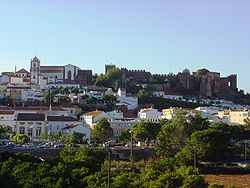Taifa of Silves
Taifa of Silves | |||||||||||
|---|---|---|---|---|---|---|---|---|---|---|---|
| 1027–1150 | |||||||||||
 Taifa Kingdom of Silves, c. 1037. | |||||||||||
| Capital | Silves (Shilb) | ||||||||||
| Common languages | Arabic, Mozarabic, Hebrew | ||||||||||
| Religion | Islam, Christianity (Roman Catholicism), Judaism | ||||||||||
| Government | Monarchy | ||||||||||
| Historical era | Middle Ages | ||||||||||
• Established | 1027 | ||||||||||
• To Seville/Almoravid dynasty | 1063–1091 / 1091–1145 | ||||||||||
• Conquered by the Almohads | 1150 | ||||||||||
| Currency | Dirham and Dinar | ||||||||||
| |||||||||||
| Today part of | Portugal | ||||||||||
The Taifa of Silves (Arabic: طائفة شلب, Ṭā'ifa Šilb) was an Arab[1] taifa kingdom that existed in what is now southern Portugal for two distinct periods:[2] from 1027 to 1063, and again from 1145 to 1150,[3] when it was finally conquered by the Almohad Caliphate.
The taifa occupied the westernmost part of the presently Portuguese region of Algarve, near Cape St. Vincent, with its capital in Silves. The Taifa of Silves was constituted in the early 11th century and starting from 1048, the power was held by the family of the Banu Muzayn,[4] including three emirs: Isa II al-Muzaffar (1048–1053), Muhammad II al-Nasir (1053–1058), and Isa III al-Muzaffar (1058–1063).[5] Under the latter the kingdom was conquered by the more powerful taifa of Seville,[6][7] led by Abbad II al-Mu'tadid.[4]
During the so-called second taifa period, which followed the fall of the Almoravid dynasty, Silves was the seat of a second, ephemeral taifa, which lasted from 1145 to 1150, when it was conquered by the Almohads.

List of Emirs
[edit]Banu Muzayn
[edit]- 'Isa I: 1027–1040/1[8]
- Muhammad I: 1040/1–1048[9]
- 'Isa II: 1048–1053[10]
- Muhammad II: 1053–1058[11]
- 'Isa III: 1058–1063[12]
al-Mundirid dynasty
[edit]- Abu'l-Walid Muhammad: 1145–1150
- To Morocco: 1150–1250
See also
[edit]References
[edit]- ^ Kennedy, Hugh (2014). Muslim Spain and Portugal: A Political History of al-Andalus. Routledge. ISBN 978-1-317-87040-1.
- ^ Ferreira, L.F. Vieira; Gomes, R. Varela; Pereira, M.F.C.; Santos, L.F.; Machado, I. Ferreira (2016). "Islamic ceramics in Portugal found at Silves Castle (8th to 13th c.): An archaeometric characterization". Journal of Archaeological Science: Reports. 8: 434–443. Bibcode:2016JArSR...8..434F. doi:10.1016/j.jasrep.2016.06.051.
- ^ Portugal-Info website, 7th Period - First Dynasty of Portugal
- ^ a b Rota Literária do Algarve website, Silves Literary Walk (2020), page 9
- ^ "Taifa | Muslim dynasty, Iberian Peninsula, Al-Andalus | Britannica". www.britannica.com. Retrieved 2024-02-21.
- ^ Syed, Muzaffar Husain; Akhtar, Syed Saud; Usmani, B. D. (14 September 2011). Concise History of Islam. Vij Books India Pvt. p. 113. ISBN 978-93-82573-47-0.
- ^ Portugal-Info website, 5th Period - First County of Portugal
- ^ Condado de Castilla website, ’Isà I Ben Abu Bakr Ben Muzayn, First King of the Taifa of Silves, article by Javier Iglesia Aparicio
- ^ Condado de Castilla website, Muhammad I Ben Isa, Amid Ad-Dawla, King of the Taifa of Silves, article by Javier Iglesia Aparicio
- ^ Condado de Castilla website, Isà II Ben Muhammad, Al-Muzaffar, King of the Taifa of Silves, article by Javier Iglesia Aparicio
- ^ Condado de Castilla website, Muhammad II Ben Isà Ben Muzayn, King of the Taifa of Silves, article by Javier Iglesia Aparicio
- ^ Condado de Castilla website, Isà III Ben Muhammad Ben Muzayn, Last King of the Taifa of Silves, article by Javier Iglesia Aparicio>
